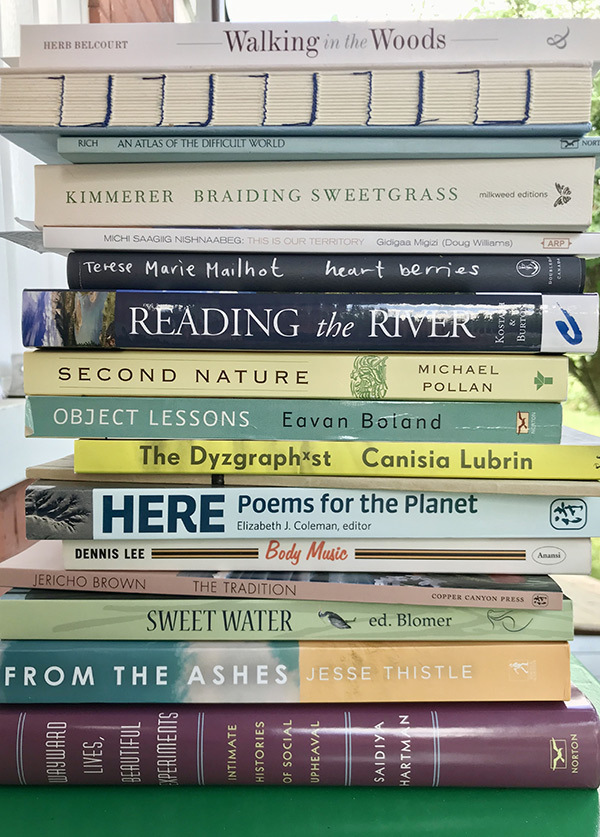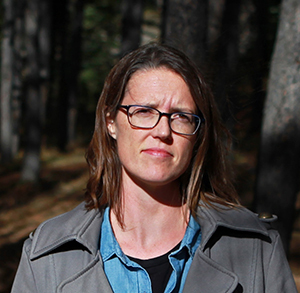What is Laurie D. Graham Reading?
By Laurie D. Graham
My job has always made the reading I do a little scrappy, a little piecemeal. Months of pandemic have exacerbated that: my time spent reading is modulating widely—for a while, all I do is read, then I can’t read at all—and I’ve been starting into more books than usual these past weeks. Maybe a disconcerting amount. I tend to have a few books on the go at once, and now I find myself with seventeen. This I do not recommend.
But at the same time, to have that big a group speaking in my head—perhaps a response to these months of isolation, as well as guides in these weeks of protest—lends a polyphony I’m finding nourishing and useful, if not a little unsteadying. (Maybe I’m nourished because it’s unsteadying?)

I’m reading poetry and non-fiction exclusively these days; these are the two genres occupying my writerly mind as well. And I’m doing more re-reading than usual: touchstone writers who’ve influenced the sort of writer I’ve become; books that I count among my favourites; ones that remind me where I am and where I come from.
Add to the list below some of the significant pieces I’ve found lately in magazines and online: Tadzio Richards’s profile, in the May issue of Alberta Views, of Chief Allan Adam, who I’d argue is one of the most significant leaders of our time; a beautiful compendium of Black women’s writing and art on liberation, put together by Nataleah Hunter-Young and Sarah Mason-Case for Canadian Art; this piece by Tim Lilburn about poets with lifelong subjects; Danez Smith’s “Crying, Laughing, Crying at the George Floyd Protests in Minneapolis” in The New Yorker.
So here’s the lot, in no particular order:
Herb Belcourt’s Walking in the Woods: A Métis Memoir
Gidigaa Migizi (Doug Williams), Michi Saagig Nishnaabeg: This Is our Territory
Adrienne Rich’s An Atlas of the Difficult World: Poems 1988–1991
Eavan Boland’s Object Lessons: The Life of the Woman and the Poet in Our Time
Robin Wall Kimmerer’s Braiding Sweetgrass: Indigenous Wisdom, Scientific Knowledge, and the Teachings of Plants
Sweet Water: Poems for the Watersheds (ed. Yvonne Blomer)
Jericho Brown’s The Tradition
Dennis Lee’s Body Music
Michael Pollan’s Second Nature: A Gardener’s Education
Saidiya Hartman’s Wayward Lives, Beautiful Experiments: Intimate Histories of Social Upheaval
Terese Marie Mailhot’s Heart Berries
Here: Poems for the Planet (ed. Elizabeth J. Coleman)
Dionne Brand’s The Blue Clerk
Muse in Prison: Eleven Sketches of Ukrainian Poets Killed by Communists and Twenty-Two Translations of their Poems (ed./trans. Yar Slavutych)
Canisia Lubrin’s The Dyzgraphxst
Jesse Thistle’s From the Ashes: My Story of Being Métis, Homeless, and Finding my Way
Myrna Kostash’s & Duane Burton’s Reading the River: A Traveller’s Companion to the North Saskatchewan River

Laurie D. Graham is a poet, editor, and the publisher of Brick magazine. Her books are Rove, Settler Education, and The Larger Forgetting, a collaborative chapbook with the Waterloo painter Amanda Rhodenizer. A third full-length book is due out with M&S in 2022. Laurie grew up in Treaty 6 territory (Sherwood Park, Alberta), and she currently lives in Nogojiwanong, in the treaty and traditional territory of the Mississauga Anishinaabeg (Peterborough, Ontario).
Photos courtesy of Laurie D. Graham. Cover image by Patrick Fore on Unsplash

